
Clive Staples Lewis, was a British writer, literary scholar, and Anglican lay theologian. He held academic positions in English literature at both Magdalen College, Oxford (1925–1954), and Magdalene College, Cambridge (1954–1963). He is best known as the author of The Chronicles of Narnia, but he is also noted for his other works of fiction, such as The Screwtape Letters and The Space Trilogy, and for his non-fiction Christian apologetics, including Mere Christianity, Miracles, and The Problem of Pain.

Mere Christianity is a Christian apologetical book by the British author C. S. Lewis. It was adapted from a series of BBC radio talks made between 1941 and 1944, originally published as three separate volumes: Broadcast Talks (1942), Christian Behaviour (1943), and Beyond Personality (1944). The book consists of four parts: the first presents Lewis's arguments for the existence of God; the second contains his defence of Christian theology, including his notable "Liar, lunatic, or Lord" trilemma; the third has him exploring Christian ethics, among which are cardinal and theological virtues; in the final, he writes on the Christian conception of God.
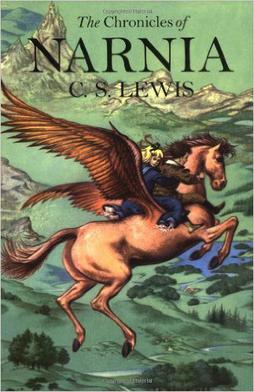
The Chronicles of Narnia is a series of seven portal fantasy novels by British author C. S. Lewis. Illustrated by Pauline Baynes and originally published between 1950 and 1956, The Chronicles of Narnia has been adapted for radio, television, the stage, film and video games. The series is set in the fictional realm of Narnia, a fantasy world of magic, mythical beasts and talking animals. It narrates the adventures of various children who play central roles in the unfolding history of the Narnian world. Except in The Horse and His Boy, the protagonists are all children from the real world who are magically transported to Narnia, where they are sometimes called upon by the lion Aslan to protect Narnia from evil. The books span the entire history of Narnia, from its creation in The Magician's Nephew to its eventual destruction in The Last Battle.
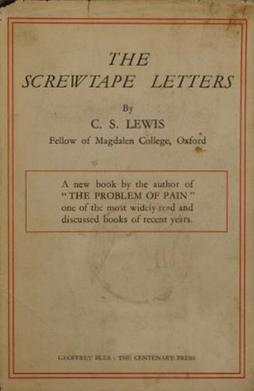
The Screwtape Letters is a Christian apologetic novel by C. S. Lewis and dedicated to J. R. R. Tolkien. It is written in a satirical, epistolary style and, while it is fictional in format, the plot and characters are used to address Christian theological issues, primarily those to do with temptation and resistance to it.

The word joy refers to the emotion evoked by well-being, success, or good fortune, and is typically associated with feelings of intense, long-lasting happiness.
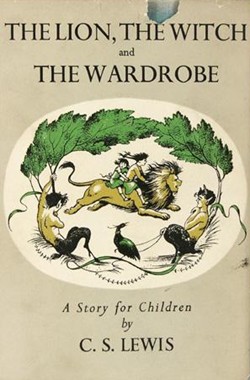
The Lion, the Witch and the Wardrobe is a portal fantasy novel for children by C. S. Lewis, published by Geoffrey Bles in 1950. It is the first published and best known of seven novels in The Chronicles of Narnia (1950–1956). Among all the author's books, it is also the most widely held in libraries. It was the first of The Chronicles of Narnia to be written and published, but is marked as volume two in recent editions that are sequenced according the stories' internal chronology. Like the other Chronicles, it was illustrated by Pauline Baynes, and her work has been retained in many later editions.
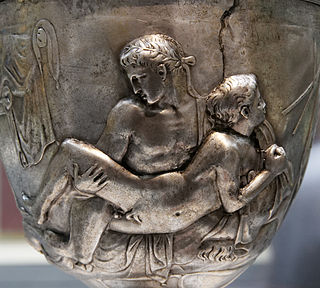
In ancient Greece and Rome, a catamite was a pubescent boy who was the intimate companion of an older male, usually in a pederastic relationship. It was generally a term of affection and literally means "Ganymede" in Latin, but it was also used as a term of insult when directed toward a grown man. The word derives from the proper noun Catamitus, the Latinized form of Ganymede, the name of the beautiful Trojan youth abducted by Zeus to be his companion and cupbearer, according to Greek mythology. The Etruscan form of the name was Catmite, from an alternative Greek form of the name, Gadymedes.

Helen Joy Davidman was an American poet and writer. Often referred to as a child prodigy, she earned a master's degree from Columbia University in English literature at age twenty in 1935. For her book of poems, Letter to a Comrade, she won the Yale Series of Younger Poets Competition in 1938 and the Russell Loines Award for Poetry in 1939. She was the author of several books, including two novels.

The Abolition of Man is a 1943 book by C. S. Lewis. Subtitled "Reflections on education with special reference to the teaching of English in the upper forms of schools", it uses that as a starting point for a defense of objective value and natural law as well as a warning about the consequences of doing away with them. It defends "man's power over nature" as something worth pursuing but criticizes the use of it to debunk values, the value of science itself being among them. The book was first delivered as a series of three evening lectures at King's College, Newcastle, part of the University of Durham, as the Riddell Memorial Lectures on 24–26 February 1943.
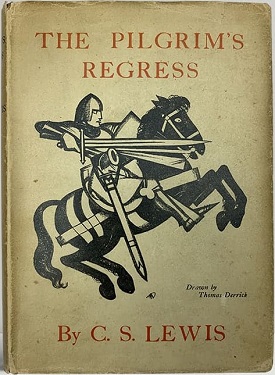
The Pilgrim's Regress is a book of allegorical fiction by C. S. Lewis. This 1933 novel was Lewis's first published work of prose fiction, and his third piece of work to be published and first after he converted to Christianity. It charts the progress of a fictional character named John through a philosophical landscape in search of the Island of his desire. Lewis described the novel to his publisher as "a kind of Bunyan up to date," in reference to John Bunyan's 1678 novel The Pilgrim's Progress, recast with the politics, ideologies, philosophy, and aesthetic principles of the early 20th century. As such, the character struggles with the modern phoniness, hypocrisy, and intellectual vacancy of the Christian church, Communism, Fascism, and various philosophical and artistic movements.
Chronological snobbery is an argument that the thinking, art, or science of an earlier time is inherently inferior to that of the present, simply by virtue of its temporal priority or the belief that since civilization has advanced in certain areas, people of earlier periods were less intelligent. The term was coined by C. S. Lewis and Owen Barfield, and first mentioned by Lewis in his 1955 autobiographical work, Surprised by Joy. Chronological snobbery is a form of appeal to novelty.
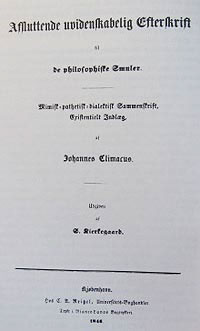
Concluding Unscientific Postscript to the Philosophical Fragments is a major work by Søren Kierkegaard. The work is an attack against Hegelianism, the philosophy of Hegel, and especially Hegel's Science of Logic. The work is also famous for its dictum, Subjectivity is Truth. It was an attack on what Kierkegaard saw as Hegel's deterministic philosophy. Against Hegel's system, Kierkegaard is often interpreted as taking the side of metaphysical libertarianism or free will, though it has been argued that an incompatibilist conception of free will is not essential to Kierkegaard's formulation of existentialism.
Carolyn Arends is a Canadian contemporary Christian musician, songwriter, and author. She is based in Surrey, British Columbia, Canada.

The Everlasting Man is a Christian apologetics book written by G. K. Chesterton, published in 1925. It is, to some extent, a deliberate rebuttal of H. G. Wells' The Outline of History, disputing Wells' portrayals of human life and civilisation as a seamless development from animal life and of Jesus Christ as merely another charismatic figure. Chesterton detailed his own spiritual journey in Orthodoxy, but in this book he tries to illustrate the spiritual journey of humanity, or at least of Western civilisation. The author Ross Douthat credits that, "Chesterton's somewhat loosey-goosey outline of history doubles as the best modern argument for Christianity I've ever read. You have to give in to the Chestertonian style, but if you do, be careful—you might just be converted."
The evolutionary argument against naturalism (EAAN) is a philosophical argument asserting a problem with believing both evolution and philosophical naturalism simultaneously. The argument was first proposed by Alvin Plantinga in 1993 and "raises issues of interest to epistemologists, philosophers of mind, evolutionary biologists, and philosophers of religion". The EAAN argues that the combined belief in both evolutionary theory and naturalism is epistemically self-defeating. The argument for this is that if both evolution and naturalism are true, then the probability of having reliable cognitive faculties is low. This argument comes as an expansion of the argument from reason, although the two are separate philosophical arguments.
The argument from desire is an argument for the existence of the immortality of the soul. The best-known defender of the argument is the Christian writer C. S. Lewis. Briefly and roughly, the argument states that humans’ natural desire for eternal happiness must be capable of satisfaction, because all natural desires are capable of satisfaction. Versions of the argument have been offered since the Middle Ages, and the argument continues to have defenders today, such as Peter Kreeft and Francis Collins.

The Language of God: A Scientist Presents Evidence for Belief is a bestselling book by Francis Collins in which he advocates theistic evolution. Collins is an American physician-geneticist, noted for his discoveries of disease genes, and his leadership of the Human Genome Project (HGP). He currently serves as the director of the US National Institutes of Health. In the book, Collins describes briefly the process by which he became a Christian.
This is a list of writings by C. S. Lewis.
The Chronicles of Narnia is a series of seven fantasy novels for children written by C. S. Lewis. It is considered a classic of children's literature and is the author's best-known work, having sold over 100 million copies in 47 languages. The series borrows characters and ideas from Classical, Norse, Irish, Arthurian, Islamic and Christian mythology. Of all the mythologies taken into consideration, the Christian one is the most fundamental for the Narnia series, due to the themes covered.
Isaac Asimov wrote three volumes of autobiography. In Memory Yet Green (1979) and In Joy Still Felt (1980) were a two-volume work, covering his life up to 1978. The third volume, I. Asimov: A Memoir (1994), published after his death, was not a sequel but a new work which covered his whole life. This third book won a Hugo Award.











